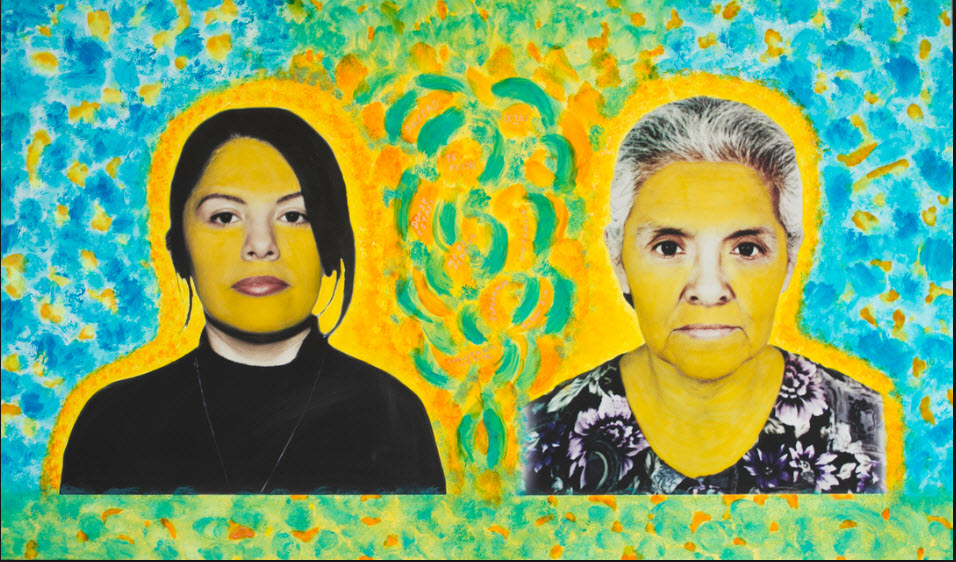A Latina daughter, her American immigrant mother, and 157 Barbies
I want to begin this blog with a story that reflects the complex relationship between American daughters raised by Latino immigrant mothers and at the same time highlights the resolution, creativity, and endurance of both Latino mothers and their daughters. The title of the blog speaks to the flexibility of identities between “Latina” and “American” during the conversations with this mother and daughter about immigration, culture, ethnicity, and nationality. This podcast narrates the story of young Latina who was not suicidal, but experienced depression during her teen years. Although she encountered difficulties with her mother as she was growing up, eventually she became the person she wanted to be without losing a loving and mutual connection with her mother. My intention here is to present an alternative to the overwhelming number of mother-blaming narratives about Latinas’ suicidality that I found online.
The overall goal of this page is to illustrate the difficulties of growing up in general; the difficulties of growing up with an immigrant mother, especially one who struggles to meet her own needs and those of her children; and the difficulties of growing up in a hostile environment that offers very little in terms of support to both immigrant mothers and their teen daughters.
In this podcast, I interview Jesselly De La Cruz and her mother Ramona. Jesselly, a psychotherapist and doctoral student, comes from an urban working poor background where her family’s aspirations for a better future were very clear. Sometimes, however, she actively pushed against these expectations, and make very difficult life decisions on her own, against the wishes of her mother.

Online sources that talk about Latino mother-daughter relationships tend to present a variety of perspectives. Some celebrate the sacrifice, strength, and dedication of immigrant Latino mothers; others focus more on the challenges and opportunities faced by the first-generation daughters who were raised by these mothers. You can also find some very sophisticated feminist and psychological analysis. Now, let’s consider online narratives about young Latinas who at one point have contemplated and/or attempted suicide. Frequently, these stories present a different perspective on the mother-daughter relationship, one that is more negative than the mother-daughter stories that are not about suicide.
The Let Them Go, Let Them Grow: the Latina Girls Project is a suicide prevention program at North Shore Child & Family Guidance Center located in Roslyn Heights, NY. I had the feeling that the name of the program was a statement to the parents of the young Latinas who attended the program. It conveys the message that the suffering of young Latinas is connected with their lack of independence and opportunities to become themselves, and that somehow their parents are responsible for this lack.
Regina Barros-Rivera, Associate Executive Director was interviewed by Lifelines: Stories from the Human Safety Net for an article about this program; these are some of her views regarding the contributing factors to the high level of suicidality among Latina teens.
The CDC study, along with other research, indicates that the major factor contributing to the high risk of depression and suicide among first-generation Latinas is the intense pressure they’re under to adhere to the traditional values of their parents’ homeland and to not become too “Americanized.”
The activities that are such an accepted part of a typical teen’s life–going to the movies, to the mall, to sleepovers–are forbidden for many Latina girls. And, if they are allowed to venture out, they’re often required to have a chaperone in the form of a parent or older brother. These unrealistic limitations make the girls feel angry, hopeless and marginalized.
Barros-Rivera’s statements corroborated my initial hunch, but she is not alone in locating a key source of distress for young Latina suicidality in the acculturation gap between parents and teens, the parents’ traditional culture, and family dysfunction. Similar statements have been repeated by professionals in many online sources addressing Latinas’ suicidality, bloggers, as well as in academic literature.
But, by listening to online stories about Latina girls who have become suicidal, a thicker narrative evolves, and an array of obscured stressors and extraordinary circumstances are highlighted.
Francisca’s Story
Francisca Abreu’s story was featured in the series Latinos in America by Soledad O’Brien. During the interview, Francisca describes a conflictual relationship with her mother ignited mainly by her lack of freedom and her multiple household responsibilities. Francisca discusses how the fact that her mother did not grow up in this country was an obstacle to their mutual understanding, an observation that further supports the acculturation gap argument. But Francisca also points to other sources for her pain: missing her father who was in the Dominican Republic, missing her country, not having her mom available (she had four jobs), and feeling like a burden.
Also, Francisca’s mom mentions that she left Francisca when Francisca was three years old and was reunited with her when the child was seven. It is interesting that in the literature of Latina suicidality, the issue of the psychological impact on children when immigrant parents leave them behind and they are reunited years later has not been identified as relevant. Such rupture and reunification–in this case a maternal separation from a three-year-old–may have weakened the mother-child attachment. Francisca’s adolescence and her corresponding individuation may have been compromised by this untimely separation at age three.
On the other hand, very little attention has been paid to how immigration affects immigrant mothers psychologically, or to the effect immigration has upon their identity development. A few psychoanalytically-minded authors, among others, have ventured into this mostly unknown territory. This is what one of these authors, Mali Mann, MD, from Stanford University, has to say about this problem:
Immigrant mothers, in particular, carry the shadow of their former lives within their newly found identity in the host country. The nature of a mother’s past life in her homeland, combined with the slow but steady change in identity as an immigrant, creates a complexity of experience that involves language acquisition, polyglottism and other cultural variants—factors that significantly influence identity formation among all immigrants, but particularly among immigrant mothers.
The phenomenological resemblance between the psychic flux of the second individuation process of adolescence and the migrant’s identity transformation is the basis for naming this process “a third individuation”. This third individuation, Mann believes, also includes an interrelated mourning process for the loss of the many things that are left behind. In Mann’s opinion, only when the immigrant mother is liberated from the mourning process she can move towards autonomy and identity consolidation. Furthermore, Dr. Mann argues that “living in hope of someday returning to one’s country of origin impedes the mourning process and the newcomer’s assimilation into the foreign culture” (p. 6).
Is it possible that immigrants can be “liberated” from this mourning process as Dr. Mann describes? The nostalgia, homesickness, and melancholy narrative of many songs, poetry, and movies about the loss and separation from the homeland, and everything that this represents to those who have migrated, tells me that it is not possible, at least not for all immigrants. A song by Mercedes Sosa, the Argentinian godmother of Latin-American music and one of my favorite singers, strengthens my argument: “Todo cambia” (everything changes).
The theoretical framework of “ambiguous loss” offers an alternative to Mann’s view: scholars today increasingly recognize that immigrant families are for the most part transnational families, meaning that immigrant “families continue to engage in family practices and maintain feelings of home and emotional proximity even across great geographical distances” (Mazzucato, 2011). The intersection of ambiguous loss and migration is explained in an article by Celia Falicov (2002):
The concept of ambiguous loss proposed by Pauline Boss (1991; 1999) describes situations in which loss is unclear, incomplete or partial. Basing her thesis on stress theory, Boss describes two types of ambiguous loss — one in which people are physically absent but psychologically present (the family with a soldier missing in action, the non-custodial parent in divorce, the migrating relative); and the second, in which family members are physically present but psychologically absent (the family living with an Alzheimer’s victim, the parent or spouse who is emotionally unavailable due to stress or depression).
Migration represents what Boss (1999) calls a “crossover”, in that it has elements of both types of ambiguous loss: while beloved people and places are left behind, they remain keenly present in the psyche of the immigrant; at the same time, homesickness and the stresses of adaptation may leave some family members emotionally unavailable to others. The very decision to migrate has at its core two ambiguous poles. Intense frustrations with economic or political conditions compel the move, but love of family and surroundings pull in another direction.
In the blog post “Young Latinos and Immigration,” I presented the concept of “mixed-status” families, whose members include people with different citizenship or immigration status; I also discussed the high percentage percentage (58%) of Latino children between 14 and 17 years of age who have at least one unauthorized parent. What I did not mention in that post is that many of those families did not immigrate as a unit. In the past, most fathers came by themselves first. Currently, however, global immigration has been feminized. Mothers in greater numbers are immigrating on their own and leaving some or all their children in the country of origin, setting the stage for the modern phenomenon of transnational motherhood: women migrating internationally and mothering from afar (Schmalzbauer, 2004). According to the Pew Hispanic Center, female migrants constitute 50.2% of immigrants, both authorized and unauthorized. A study of the experiences of transnational Latino mothers, Stenberg (2009), found that “Latina women experiencing transnational motherhood find meaning in mothering from afar through sacrifice, suffering, and hopefulness for a better life for their children, and for family reunification.” I am including here part of an interview Stenberg (2009, p.36) conducted with a transnational Mexican mother, Rosario, that illustrates the sorrow of family fragmentation:
It is very difficult. Leaving my daughter is too much. It is very difficult because one comes here supposedly to give them the best – a better life and all but what really is best for them is to be with their mother… To listen to her saying ‘Mommy I want you to come back’ is too much … but if I leave it would be very difficult. Over there I don’t have a way of giving her the things that she needs. Things like food; it is hard to be there and not have anything to give your child to eat. I left my daughter with my mother. It is very difficult and now I just miss her too much … Now my mother says that my daughter does not need me. Now it is very difficult. My mother and I are going through a hard period right now because I want to bring my daughter here. I want something better for her. When I speak to my daughter now she says, ‘Mom I don’t love you anymore’. I know that she says that because my mother tells her that if I really loved my daughter I wouldn’t have had another baby.
In another article by Mcguire and Martin (2007) regarding family fragmentation, the authors make the following comment:
“In the nursing literature the postcolonial historical context that situates transnational migration patterns from poor to rich countries has only recently begun to become evident. This particular pattern bears scrutiny because of the physical and mental health implications foregrounded by the intersections of race, class, and gender that are both product of, and produced in, postcolonial relations”.
This is a key statement. In the area of mental health, as in nursing, the postcolonial historical context of immigration and its consequences in parenting, and in mothering specifically, are frequently invisible.
The relationship between migration, its related processes, and the context of family life is complex; it is understandable that many researchers and writers tend to oversimplify it. Here, however, I have presented a more nuanced examination of the impact on immigration on the mother, and how this can affect her identity and emotionality. This is important to include because the impact of migration on the mother impacts, in turn, her parenting role. Leaving mothers’ experiences out of these conversations leads to incomplete, non-relational pictures of their connections with their daughters.
But now, let’s turn to the story of another young Latina who attempted suicide and hear what she has to say about her relationship with her mother. Lack of freedom, too much household responsibility, and gender role expectations were also part of Yanira’s story.
Yanira’s story
Like Francisca, Yanira fought with her mother constantly as a result of her mother’s suffocating protectiveness. Her emotionality, already compromised by the constant conflictual relationship with her mother, took a turn for the worse when her mother was diagnosed with cancer. As a result Yanira had to assume total responsibility for her mother, her siblings, and the household.
As I described earlier, there are personal and familial stressors that are endemic to the immigrant experience. The crisis that Yanira experienced as a result of her mother’s illness, however, rather than her mother’s identity as an immigrant, may have precipitated trauma. The lack of support to alleviate the heavy burden Yanira had to carry by herself can no longer be located exclusively on her family and her culture, but in the social environment.
Story of Imalay
Imalay, another teen Latina who attempted suicide, faced similar adverse circumstances. Not only her mother, but also Imalay herself, suffered from serious illness. Like Yanira, Imalay was left to manage on her own, but unlike Yanira, Imalay does not complain about gender role expectations or lack of freedom. In the video below, she emphasizes her and her mother’s deep sense of isolation, their abandonment by her father, the lack of support from others, and her loneliness. Imalay states that she is no longer depressed. She and her mother have found a family, a community, in the program they are both attending.
Some authors have criticized the over-reliance on culture, through the use of the concept of acculturation, as the preferred lens to explain immigrant health outcomes because it obscures the impact of structural factors on immigrant health disparities. These authors argue that a richer understanding of the social factors involved in immigrant health requires an intersectional approach. An examination of intersecting social categories such gender and gender identity, class, legal status, and race have rarely been mentioned in Latina suicidality literature, and for the most part have seemed to be irrelevant in the online sources. Luis Zayas and others have mentioned some socio-demographic categories as separated factors impacting Latinas’ suicidality, but not as systems of oppression which are mutually constituted to produce inequality. We can name several intersecting social categories in the lives of the young Latinas whose stories are included in this post: class, race, and gender.
Ruby’s Story
The story of Ruby brings additional intersecting social categories: sexual orientation and gender expression. Ruby describes a painful coming-of-age tale full of experiences of discrimination, bullying, and self-destructiveness. As a queer youth of color, Ruby was the target of identity-based discrimination. In a study focused on the relationship between discrimination and bullying on the one hand, and depressive symptoms, delivered self-harm, and suicidal ideations in teenagers on the other, the authors concluded the following:
We found evidence that discrimination attributes and bullying co-occur among adolescents and that specific combinations of these experiences were associated with heightened depressive symptoms, suicidal ideation and deliberate self-harm.
Curiously, Rudy does not mention her family. We do not know how accepting the family was of her identities. According to research, LGBT youth from highly rejecting families were more than 8 times as likely to try to take their own lives by the time they were young adults. In the Latino community, LGBT youth very frequently feel rejected and unsafe. If you are interested in exploring more about this topic, I would recommend watching the short film “You are dead to me” featured in the PBS Film Festival 2014. It is a powerful illustration of the complicated relational dynamics between a Latino mother and her trans-teen, and how their unresolved differences left them estranged.
In this post, I have used different theoretical frameworks to analyze stories of young Latinas–many of them with a history of suicidality-and their immigrant mothers. The picture is always complicated regardless of the lenses used for the analysis. There may be some truth to the name of a videotaped conference produced by Maria Hinojosa, from the Futuro Media Group, which implies that growing up Latino in the US is such a challenge that a youth might be considered lucky if she makes it to 25.


